Francisco Salamone
Francisco Salamone (June 5, 1897 – August 8, 1959) was an Argentine architect of Italian descent who, between 1936 and 1940, during the Infamous Decade, built more than 60 municipal buildings with elements of Art Deco style in 25 rural communities on the Argentine Pampas within the Buenos Aires Province. These buildings were some of the first examples of modern architecture in rural Argentina.
Francisco Salamone | |
|---|---|
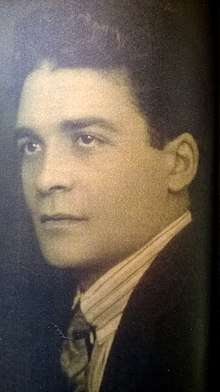 | |
| Born | June 5, 1897 |
| Died | August 8, 1959 (aged 62) |
| Resting place | La Recoleta Cemetery |
| Nationality | Argentine |
| Alma mater | National University of Córdoba |
| Occupation | Architect and engineer |
| Known for | City halls, slaughterhouses and cemeteries |
Life
Salamone's was born in the town of Leonforte, Sicily in 1897, son of Salvatore Salamone and Antonia D'Anna.[1] After leaving the Otto Krause Technical School in Buenos Aires he continued his studies in the National University of Córdoba where he graduated in 1917 with a degree in architecture and civil engineering.
Salamone married Adolfina Croft, the daughter of the Austria-Hungarian Vice-consul in Bahia Blanca, Argentina, with whom he had four children: Ricardo, Roberto, Annie and Stella Maris. He became a good friend of Dr. Manuel Fresco, a conservative politician who was governor of the Province of Buenos Aires during the period 1936–1940. During Fresco's term in office a large number of new municipal buildings were built and the roads, irrigation and communications networks in the province were largely improved. Although many of the new buildings were of little aesthetic value, those that Fresco commissioned Salamone to design were a notable and very personal combination of Art Deco, authoritarianism, functionalism, Italian Futurism and propaganda on a vast scale. The use of reinforced concrete made it possible to construct buildings to a height that at that time made them symbols of municipal power and authority.
The rural towns in which Salamone's buildings appeared were 500 km or more from Buenos Aires city, and were either frontier towns, built at the end of the nineteenth century on the edge of Indian territory, or were situated at regular intervals along newly built rail links. These towns were named after the colonels and generals who led the Conquest of the Desert and engineers who pioneered the building of the railways in this part of the Province.
When Fresco's term as Provincial governor came to an end in 1940, Salamone and his family moved back to Buenos Aires, where he designed just two more buildings in Rationist style. He died on 8 August 1959, relatively forgotten, but leaving behind him a monumental architectural inheritance on the Argentine pampas. He was buried in Recoleta Cemetery.
Buildings
Salamone's work comprised three types of municipal buildings:
- Town Halls: these are characterised by their massive proportions and high tower, taller than the local church tower, to symbolise the advance of civilisation over the Pampas and recalled both the medieval palazzi comunali and the designs of Benito Mussolini's Italy. These buildings were clearly intended to be the centre of urban life. Examples are to be found in Carlos Pellegrini, Alberti, Carhué, Guamini, Adolfo Alsina, Laprida, Rauch, Balcarce, Tornquist, Puán, Chillar, Saldungaray, Gonzales Chaves and Coronel Pringles.
- Cemetery Portals: these were also characterised by their massive proportions. Examples can be found in Saldungaray, Laprida, Azul, Salliqueló and Balcarce.
- Slaughterhouses: these are functional in design, on the outskirts of towns, and have become obsolete with the introduction of modern butchery techniques and the advent of cold-storage plants. Examples can be found in Tres Lomas, Balcarce, Carhué, Guaminí, Coronel Pringles (whose tower is in the form of the blade of a knife), Azul, Laprida, Vedia, Villa Epecuén, Salliqueló, Chillar and Carlos Pelegrini.
Works
City halls
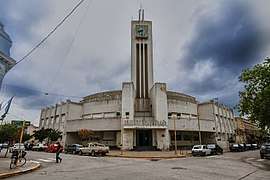 Adolfo Gonzales Chaves city hall
Adolfo Gonzales Chaves city hall- Carhué city hall
- Coronel Pringles city hall
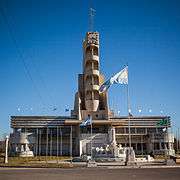 Guaminí city hall
Guaminí city hall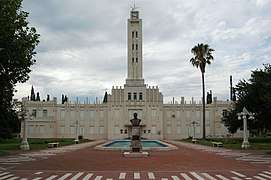 Pellegrini city hall
Pellegrini city hall- Rauch city hall
Slaughterhouses
- Azul slaughterhouse
- Coronel Pringles slaughterhouse
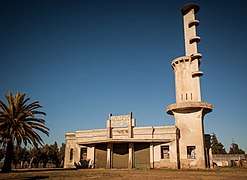 Guaminí slaughterhouse
Guaminí slaughterhouse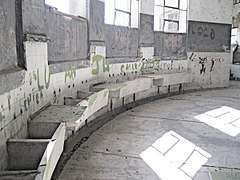 Guaminí slaughterhouse inside
Guaminí slaughterhouse inside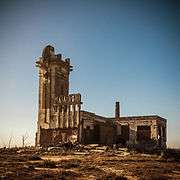 Villa Epecuén slaughterhouse
Villa Epecuén slaughterhouse
Cemetery portals
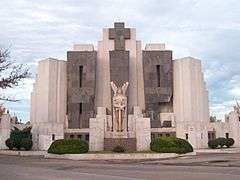 Azul cemetery
Azul cemetery- Angel in the Azul cemetery
- Laprida cemetery
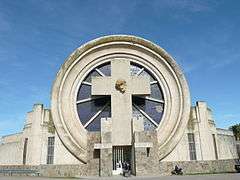 Saldungaray cemetery
Saldungaray cemetery
References
- Alberto Bellucci, Monumental Art Deco in the Pampas: The Urban Art of Francisco Salamone, J. Decorative & Propaganda Arts, Argentine Theme Issue, 1992.
- Photos and opinions by Leandro Aguirre
- Tom Shaw & Edward Shaw, Salamone, La Consagración. Monumental Art Deco En Las Pampas 1997-2007, El Centro Cultural Borges, Buenos Aires, 2007.
External links
| Wikimedia Commons has media related to Francisco Salamone. |